Ellie Irons
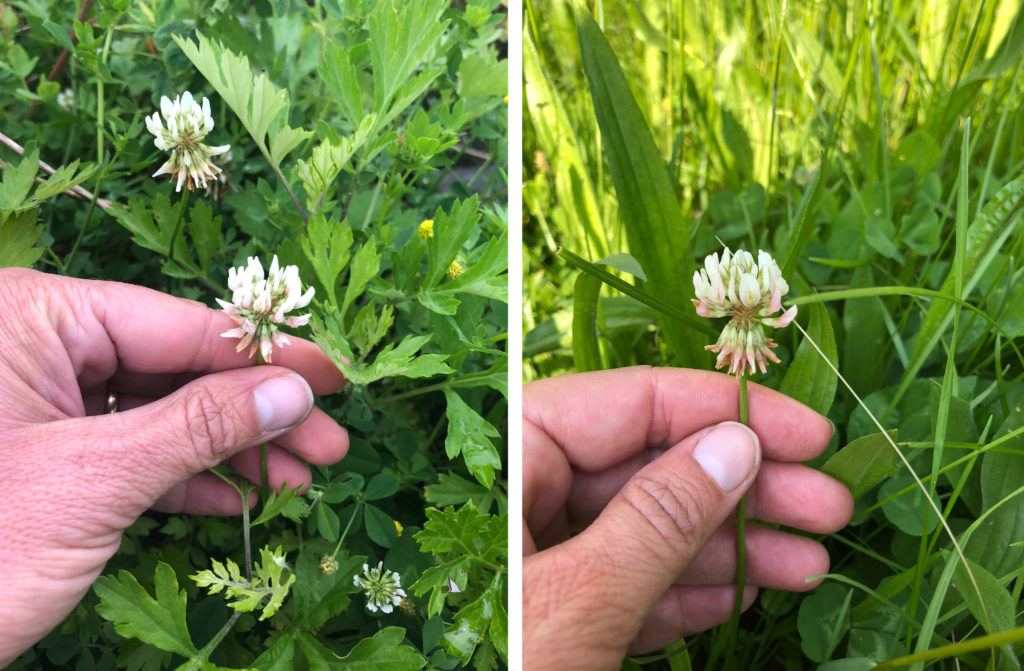
White clover blooms in two disparate habitats in Troy, New York: a brownfield on a former junkyard (left) and a residential lawn subject to frequent mowing (right).
When the phrases “annoying weed” and “urban evolution” ran in a headline in The New York Times last year, I knew about it right away. Yes, I have a Google alert set up in an attempt to catch these sorts of things, but in this case, it was actually my human network who notified me, beating out Google by at least twenty hours. The article in question, a Trilobites column bearing the headline “White Clover Can Be an Annoying Weed. It May Also Hold Secrets to Urban Evolution” was variously emailed, tweeted and texted to me in days following its publication.[1]
The column was written in response to the publication of a journal article, which appeared in the Proceedings of the Royal Academy of Sciences in June. Titled “Contrasting the effects of natural selection, genetic drift and gene flow on urban evolution in white clover (Trifolium repens),” it does not contain the phrase “annoying weed,” and in fact fails to use the term weed at all.[2] It identifies white clover as “a perennial herbaceous plant, native to Eurasia and introduced globally to temperate environments.”[3] While this could be interpreted as merely a schism in the kinds of language (colloquial versus technical) used in journalistic versus scientific circles, I think there is more at stake. In what follows I will attempt to unpack some of the weight borne by the term weed (and its omission), while also asking how traits described as “weedy” relate to urban evolution and human complicity in the Sixth Extinction.
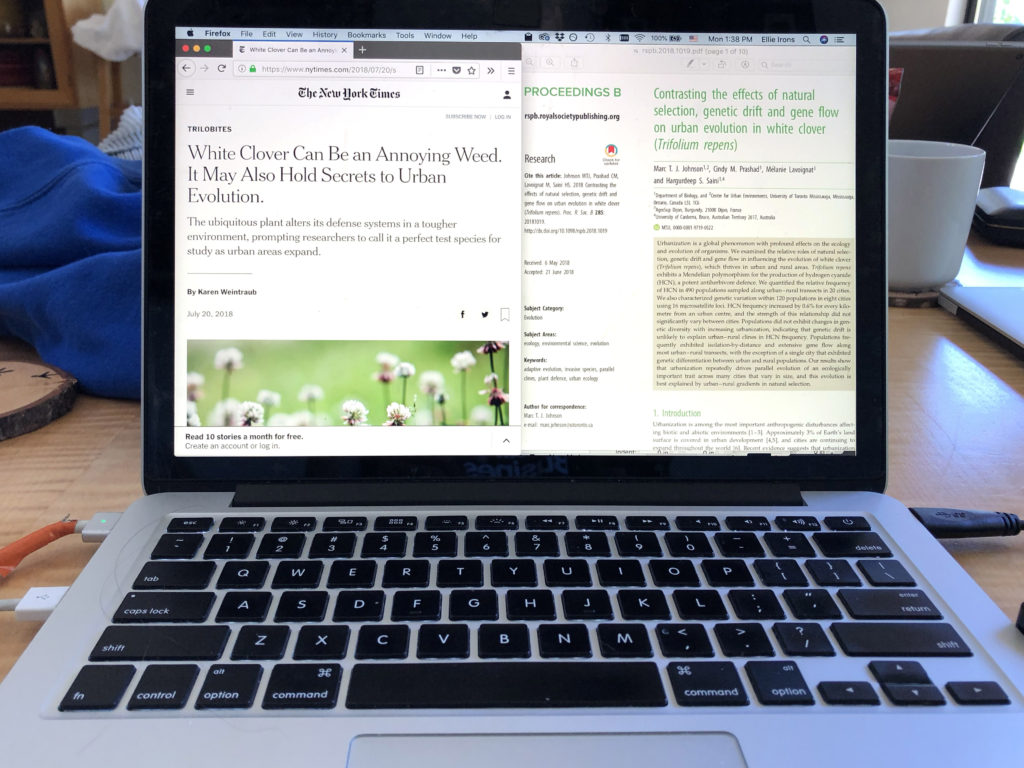
Two articles on white clover as seen on the author’s laptop screen, July 2019.
As an interdisciplinary artist who spends a lot of time observing and interacting with spontaneous urban plants (aka “weeds”) as part of my practice, I am quite familiar with white clover. It’s a dependable presence and co-conspirator that often involves itself in the public interventions and fieldwork-based projects I do with the Environmental Performance Agency and the Next Epoch Seed Library. My collaborators and I find it thriving everywhere from manicured lawns to street tree pits to brownfield sites. I’ve even found that it adapts well to indoor living, growing complacently on my kitchen windowsill in a yogurt cup after months of display in a gallery space.
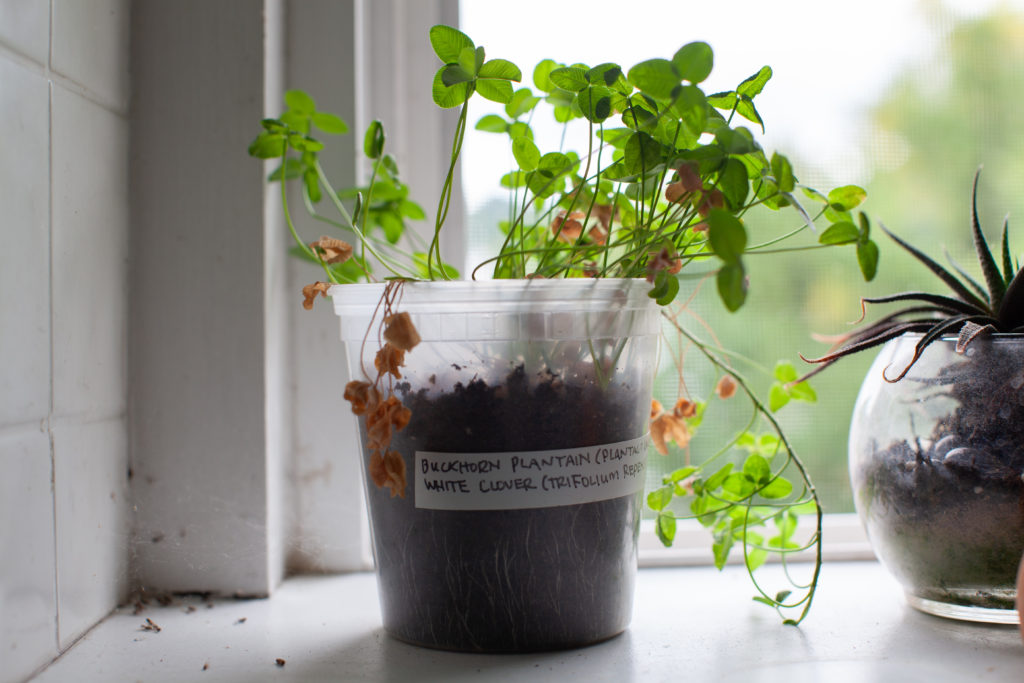
White clover (Trifolium repens) sprouted from seeds collected in Bushwick, Brooklyn, growing on the author’s windowsill. It’s co-habitant, buckhorn plantain (Plantago lanceolata) did not adapt as readily to indoor living. Photo courtesy Dan Phiffer.
Given the species’ ubiquity, I wasn’t surprised to learn it had become the focus of a study on urban plant evolution. Over the last decade, a solid subset of ecologists have shifted focus from biological stations in the so-called wilderness to the streets and sidewalks of rapidly growing cities.[4] Many have asked questions about if and how the pressures of urban life are changing the nonhuman species who manage to stick it out. Some even cite cities as a kind of petri dish for studying the effects of global warming, given that they tend to have relatively higher annual temperatures.[5] To date, there is a growing body of research that answers an emphatic yes to the question of whether rapid evolution is taking place in cities.[6] Plants, animals, insects, microbes: are all evolving differently, and more rapidly, in cities than elsewhere.[7]
The study in question sought to answer a more specific subquestion about urban evolution, one that white clover is particularly well-suited to answer. Taking advantage of the fact that white clover thrives in cities large and small and in lawns and pastures in non-urban areas, the authors were able to make a useful comparison. They showed that evolution in clover is taking place across different cities, of different sizes, in similar ways. White clover plants are not just randomly evolving due to chance (genetic drift or the founder effect), but rather are responding in predictable ways in cities large and small in comparison to their rural-dwelling counterparts. This means they are evolving in parallel, a form of adaptive evolution where traits are being selected repeatedly in response to the way humans organize and interact with land.
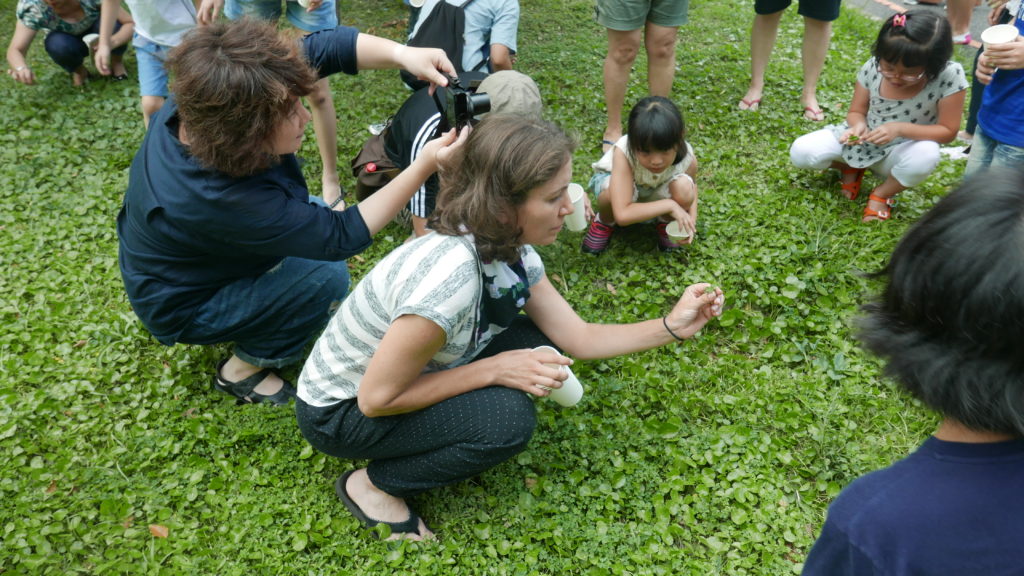
The author and workshop participants collecting clover and other weedy species in a public park in Taipei, Taiwan for a plant pigment workshop with MOCA Taipei and Bamboo Curtain Studios, June 2017. Image courtesy Bamboo Curtain Studios.
White clover has a long relationship with humans and our attendant landscape alterations. It exists in cultivated, wild, and what we might call intermediate feral forms, all of which are considered subspecies of Trifolium repens.[8] While its ancestors most likely evolved in the Mediterranean region more than 16 million years ago, the species spread throughout Europe and Central Asia before recorded history, and is thus considered native in these regions.[9] White clover has been evolving alongside humans as long as agriculture has existed, and perhaps even before. It provided protein-rich forage for the herbivores that were the ancestors of our domesticated grazers, who probably helped with its spread through Europe and Asia. By the early 1600s it was being cultivated in Holland as Dutch White Clover and was subsequently exported around the world during the during the centuries of colonization and globalization that followed.[10] Even today it is purposefully added to turf and pasture seed mix along with grass, because it is tough and resistant to trampling, supplements forage for livestock, and enriches soil by fixing nitrogen.[11] So, while it is fascinating to see how quickly clover is adapting to urban life, it is also worth considering how its long co-evolution with human activity may have prepared it for life in cities. Clover is well adapted to sheering and trampling, whether it comes from elk and cattle or lawnmowers and human feet.
(Video): An automower working on a lawn comprised of grass and white clover on the grounds of the Royal Palace in Oslo, Norway, June 2019.
So, what does the term weed have to offer in this context? Well, like white clover, the term has been with us for quite some time and has gone through a series of evolutions in its meaning and usage, from the technical to the poetic. Like clover, it continues to evolve under the pressures of the current moment and I find that the two illuminate one another in intriguing ways.
In its most common usage, the term weed has been part of the English language for at least a millennium. The OED cites it as appearing in Boethius’ The Consolation of Philosophy as early as 888, where it took the Old English form weod.[12] It appears regularly in English literature, philosophy, and scientific texts throughout the colonial period and industrial revolution, from Shakespeare’s Venus and Adonis (1593) to John Worlidge’s Systema agriculturæ (1669) to Emily Dickinson’s “All overgrown by cunning moss,” (1860, published 1924).[13]
In these examples it’s used pejoratively to refer to spontaneously growing herbaceous plants that are either undesirable (competing with cultivated plants or more desirable wild plants) or simply unintentional and thus less valuable. Ralph Waldo Emerson’s well known quotation “What is a weed? A plant whose virtues have not yet been discovered…” reveals that at least by the early 20th century, at which time white clover was well-established in the United States, the relative and context-sensitive nature of the term had been acknowledged.[14] The primary OED definition from 1965 reveals why the term is worth contesting: “Weed: A herbaceous plant not valued for use or beauty, growing wild and rank, and regarded as cumbering the ground or hindering the growth of superior vegetation.”[15] The subjective nature of beauty, and the culturally specific nature of what is considered superior when it comes to utility and desirability provide clear avenues for productive critique.
Since the 1960s, with the expansion of industrial farming, the rise of ecology as an independent discipline, and the launch of the modern environmental movement, uses of the term weed have fractured, with euphemisms and alternatives proliferating. In 1962, Rachel Carson reframed insecticides and herbicides as “biocides,” providing a powerful argument for re-thinking the growing use of toxic chemicals to control unwanted forms of life.[16] We can now speak of “spontaneous urban plants” and “volunteers” if we prefer. If some have retreated from the term in favor of more specific or euphemistic language, industrial agriculture has moved to embrace it wholeheartedly. The increasingly professionalized field of Weed Science has advanced an un-ironic, utilitarian use of the term that is based on economic impacts of “noxious” and “pest” species as exemplified in the series of journals published by the Weed Science Society of America.
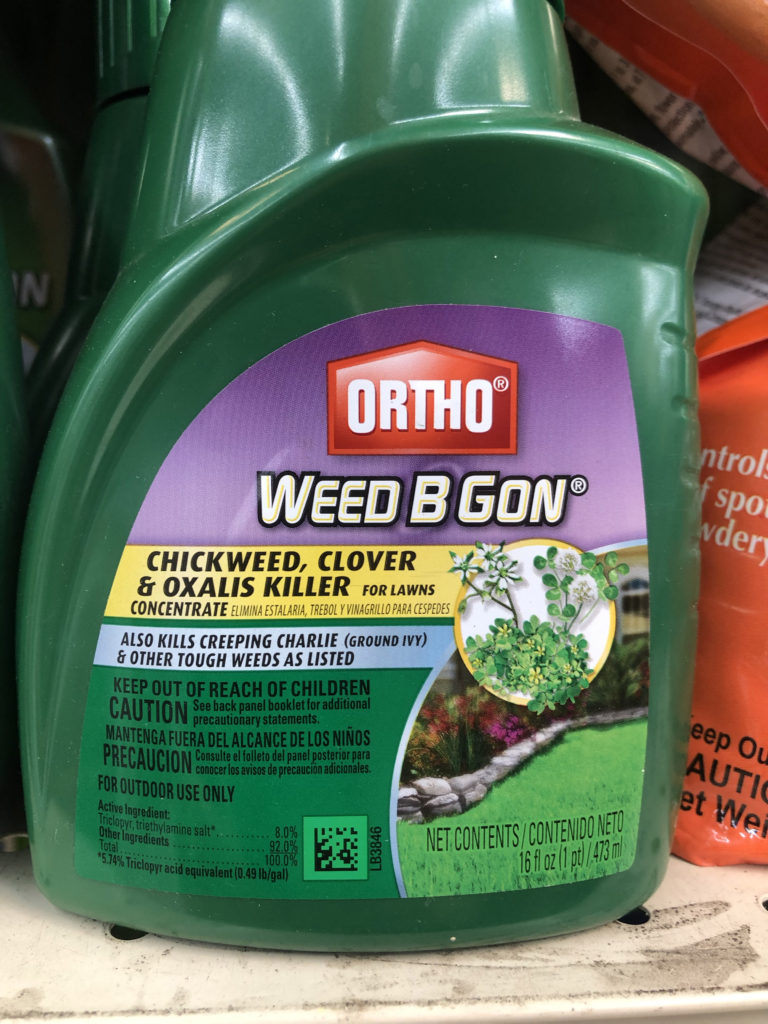
Herbicide for use on residential lawns, featuring illustrations of clover, chickweed (Stellaria media) and wood sorrel (Oxalis stricta), photographed at a hardware store in Placerville, California, June 2019.
Alongside the terms’ re-entrenchment in industrial agriculture, since the 1980s the related concept of invasive species has been on the rise. Originally defined by Charles Elton in 1958, to describe “the enormous increase in numbers of some kind of living organism” often due to introduction to a novel environment, the term is now generally used to describe species that are, or are likely to “cause economic or environmental harm to human health.”[17] Both terms continue to be contested in the sciences and beyond, where arguments around native, introduced, naturalized, and invasive species abound.[18] In popular discourse invasive, weedy, and non-native are often conflated, used interchangeably or in tandem with one another, at times in ways that reveal disturbing parallels with white supremacist and anti-immigrant rhetoric in both the United States and Europe, where populist movements and eco-fascism have the potential to converge in frightening ways.[19]
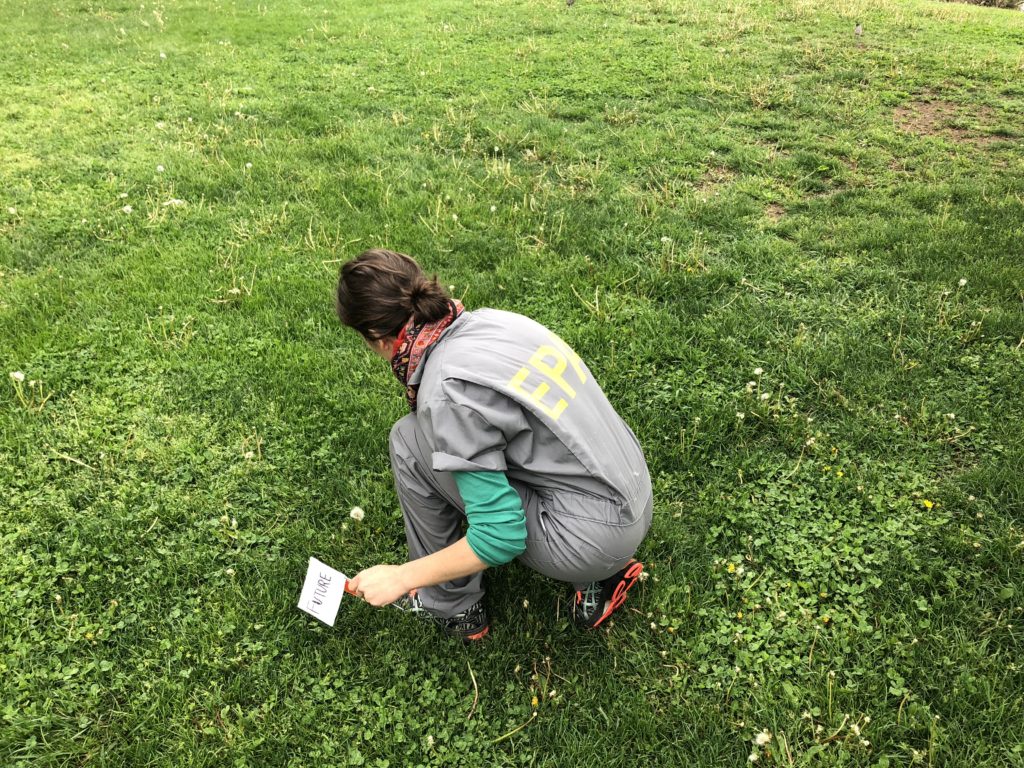
Contemplating the past, present, and future of white clover and other “turf weeds” during the Environmental Performance Agency’s workshop “Plant Talk, Human Talk: An EPA Training for the Beginning of the World” at the New York Hall of Science, May 2018. Image courtesy the Environmental Performance Agency.
In the New York Times column, these layers of meaning are set aside, or at least lurk well below the surface. After appearing in the headline, the term weed emerges again when the author writes that clover is “considered a nuisance or a weed when it pops up in luscious suburban lawns, long the bane of gardeners and homeowners sodding, sprinkling and nurturing the greenest of grasses.”[20] Is a weed somehow different than a nuisance? Is it more than annoying, as suggested in the headline? When and why? While it might be a common perception that clover is an unwanted interloper in lawns, as noted earlier, clover has been actively cultivated by humans and purposefully introduced in turf mixes for generations. This contradiction reflects the circular logic of weediness, in which weeds only exist in relationship to human preferences and needs. The plants that thrive alongside us are protean in the roles and meanings they play for us, as is the term weed.

The meeting point of a mixed clover/grass lawn (left) and freshly laid pure-grass turf (right) on the grounds of Syracuse University.
The reflexive nature of the co-evolutionary process between clover and humans points to a relatively recent development in the way the term weed is used. By the closing decade of the 20th Century, popular writers like Michael Pollan and David Quammen were responding to the biological characteristics of weedy species (they “reproduce quickly, disperse widely, tolerate a broad range of habitats, take hold in strange locations, succeed in disturbing ecosystems and resist eradication once they’re established”) by pointing out that all these traits are also traits that belong to humans.[21] This leads them to the conclusion that humans are actually the most successful weedy species on the planet, and that the explosion of other weedy species have us to thank. This is an attractive concept that I’ve been presented with repeatedly when I discuss my work with weedy species and it is worth considering more deeply.
To begin with, realizations like this one arose alongside—and perhaps in response to—foundational work in feminist and ecofeminist theory by the likes of Val Plumwood, Carolyn Merchant, Donna Haraway and countless others, who, throughout the 1980s and 90s, laid the groundwork for dismantling predominantly Western systems of thought that put humans outside of and above the rest of nature.[22] And while it’s important to acknowledge the feminist roots of the contemporary challenge to the nature/culture divide, Métis artist and writer Zoe Todd makes the essential point that these ideas themselves, while slowly entering Western Science and now hailed as an “ontological turn” in the humanities, have long formed the basis of many indigenous cosmologies worldwide.[23] So, while the conclusion that humans are a weedy species has an appealing logic, thinking with feminist theorists like Todd and Haraway reminds me that any universalizing trope is worth interrogating, however attractive.[24] So, let’s not accept the expansion of weediness to include humans as the definitive step in the terms’ evolution. Instead, let’s ask: what are the baseline environmental situations that facilitate a “weedy” response in organisms, human or otherwise?
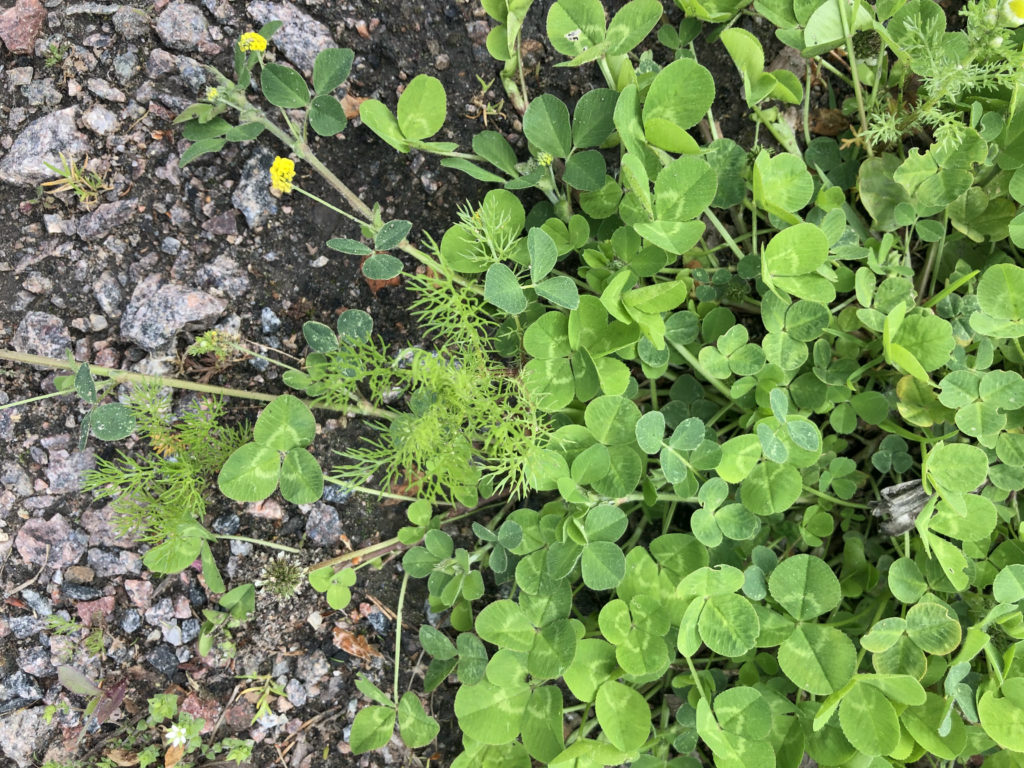
White clover sprouting at the edge of a parking lot in Linköping, Sweden, alongside pineapple weed (Matricaria discoidea), black medic (Medicago lupulina), and chickweed (Stellaria media).
Returning to the discipline of ecology might be helpful here. Recent studies have shown that whole species are not necessarily intrinsically weedy, despite Pollan’s assertion that “absolute weediness” exists.[25] Rather individual organisms or populations act weedily in certain contexts.[26] So, what then, is the context that is relevant here? One obvious context we might attend to is that of capitalist growth and resource extraction accompanied by massive ecosystem disturbance, which is hitting different regions at varied intensities. As Anna Tsing outlines in her recent work on disturbance ecologies, ecosystems are patchy, as are the causes and effects of the Sixth Extinction.[27] In this context, the shifting fate of certain populations, whether they are flourishing, declining, migrating, or adapting, becomes a signpost to be read, if we can learn to decipher it. The tools of urban ecology, if applied in this spirit, can help us see that white clover and many of its human co-habitants are the passengers, not the drivers, of our ecological crisis.[28] Life responds, adapting or disappearing, while an economic system based on endless growth benefits a small proportion of the human population at the expense of multispecies livability, a state of affairs that theorists like Haraway and Jason Moore have sought to rename the Capitalocene.[29]
Following Tsing further, whatever “cene” it is we are inhabiting, we would do well to acknowledge weedy plants as our companion species, and strive to learn from them, as plant biologist Robin Wall Kimmerer sagely recommends in her writings incorporating traditional ecological knowledge.[30] In this light, by studying white clover we are actually studying ourselves, so entangled are the members of this species with human-driven land use patterns. So, while the authors of the Royal Society paper eschew the term weed, the discoveries they relate are fittingly described by it, if one allows the term to live and breathe in many registers at once.
Labeled a weed, a single clover plant becomes simultaneously an annoyance to be subdued by human ingenuity and a resilient truth-teller leading us to the secrets of urban evolution. Today’s weeds are both muse and portent Janus-faced beings proffering tales of resistance and hope while in the same breath whispering “I wouldn’t be here without you.” Uttered in this register, the term is one of many fraught words joining the growing lexicon swirling around the so-called Anthropocene. Like Anthropocene itself, it is a term I use with ambivalence, one I find salient precisely due to the residue it retains and the cognitive dissonance it affords. With this residue on my tongue, to use the word weed today is to acknowledge the complexity of the current ecological crisis and my complicity in it.
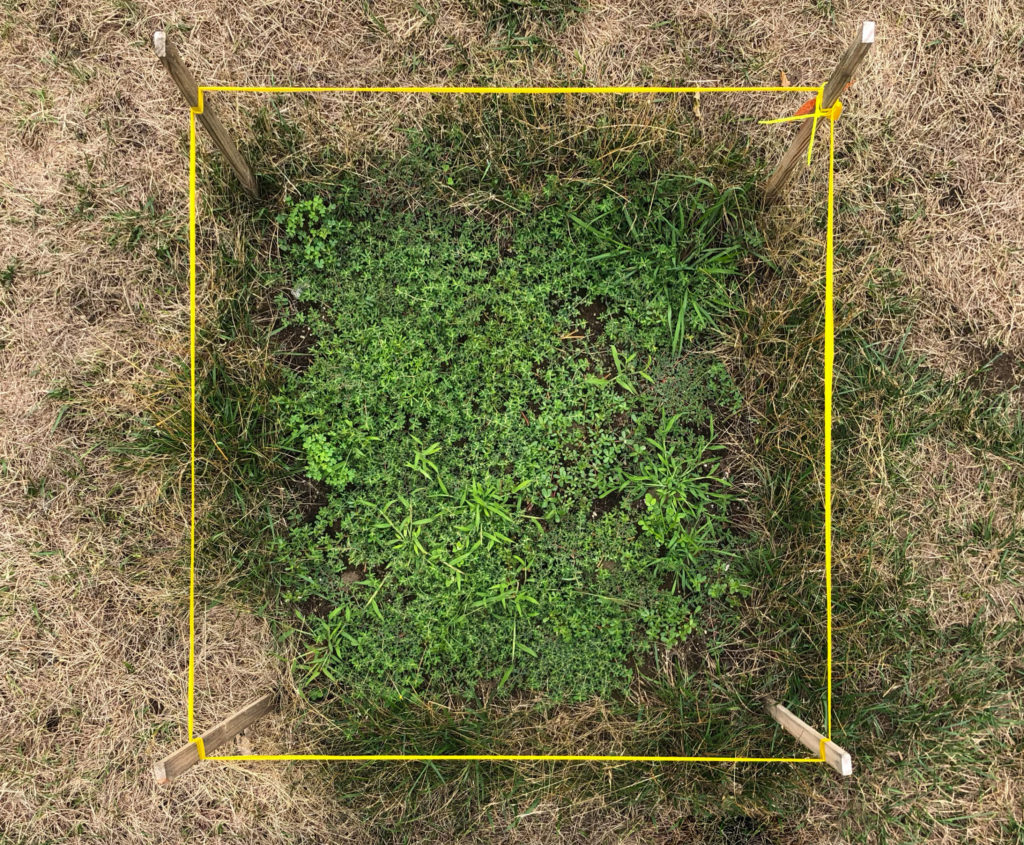
White clover and other spontaneous plants thriving in the midst of a thirsty lawn in the heat of July, as part of the author’s ongoing project Lawn (Re)Disturbance Laboratory, carried out in collaboration with the Next Epoch Seed Library. Image courtesy the author and the Next Epoch Seed Library.
An earlier iteration of this essay was published in September 2019 under the titles “Why Say Weed in the Anthropocene” and “Contrasting the effects of natural selection, genetic drift and gene flow on urban evolution in white clover (Trifolium repens)” on the blog Inhabiting the Anthropocene.
All images courtesy the artist except where noted otherwise.
[1] Karen Weintraub, “White Clover Can Be an Annoying Weed. It May Also Hold Secrets to Urban Evolution.,” The New York Times, August 7, 2018, sec. Science, https://www.nytimes.com/2018/07/20/science/white-clover-evolution.html.
[2] Marc T. J. Johnson et al., “Contrasting the Effects of Natural Selection, Genetic Drift and Gene Flow on Urban Evolution in White Clover (Trifolium Repens),” Proceedings of the Royal Academy. Biological Sciences 285, no. 1883 (July 18, 2018), https://doi.org/10.1098/rspb.2018.1019.
[4] Timon McPhearson et al., “Advancing Urban Ecology toward a Science of Cities,” BioScience 66, no. 3 (March 1, 2016): 198–212, https://doi.org/10.1093/biosci/biw002.
[5] Elsa Youngsteadt et al., “Do Cities Simulate Climate Change? A Comparison of Herbivore Response to Urban and Global Warming,” Global Change Biology 21, no. 1 (2015): 97–105, https://doi.org/10.1111/gcb.12692.
[6] Marc T. J. Johnson and Jason Munshi-South, “Evolution of Life in Urban Environments,” Science 358, no. 6363 (November 3, 2017): eaam8327, https://doi.org/10.1126/science.aam8327.
[7] P.-O. Cheptou et al., “Rapid Evolution of Seed Dispersal in an Urban Environment in the Weed Crepis Sancta,” Proceedings of the National Academy of Sciences 105, no. 10 (March 11, 2008): 3796–99, https://doi.org/10.1073/pnas.0708446105; Matthew Combs et al., “Urban Rat Races: Spatial Population Genomics of Brown Rats (Rattus Norvegicus) Compared across Multiple Cities,” Proc. R. Soc. B 285, no. 1880 (June 13, 2018): 20180245, https://doi.org/10.1098/rspb.2018.0245; Annie Karni, “New Breed of Ruffi-Ant Found in Manhattan,” New York Post, September 2, 2012, https://nypost.com/2012/09/02/new-breed-of-ruffi-ant-found-in-manhattan/; Sandra L. McLellan, Jenny C. Fisher, and Ryan J. Newton, “The Microbiome of Urban Waters,” International Microbiology: The Official Journal of the Spanish Society for Microbiology 18, no. 3 (September 2015): 141–49, https://doi.org/10.2436/20.1501.01.244.
[8] USDA, Agricultural Research Service, National Plant Germplasm System. 2019. Germplasm Resources Information Network (GRIN-Taxonomy). National Germplasm Resources Laboratory, Beltsville, Maryland. URL: https://npgsweb.ars-grin.gov/gringlobal/taxonomydetail.aspx?300625. Accessed 4 July 2019.
[9] Nick W. Ellison et al., “Molecular Phylogenetics of the Clover Genus (Trifolium–Leguminosae),” Molecular Phylogenetics and Evolution 39, no. 3 (June 2006): 688–705, https://doi.org/10.1016/j.ympev.2006.01.004.
[10] A. C. Zeven, “Four Hundred Years of Cultivation of Dutch White Clover Landraces,” Euphytica 54, no. 1 (April 1, 1991): 93–99, https://doi.org/10.1007/BF00145635.
[11] “Agronomic Basics: White Clover,” Riverdale Ag Service Inc, accessed August 31, 2018, http://www.riverdaleagservice.com/index.cfm?show=10&mid=13&pid=4;
[12] “Weed, n.1,” in OED Online (Oxford University Press), accessed July 4, 2019, http://www.oed.com/view/Entry/226761.
[13] Ibid.; Emily Dickinson, The Complete Poems of Emily Dickinson with an Introduction By Her Niece Martha Dickinson Bianchi (Boston: Little Brown and Company, 1929).
[14] Ralph Waldo Emerson, The Complete Works of Ralph Waldo Emerson: With a Biographical Introduction and Notes (New York and Boston: Houghton, Mifflin and Company, 1904).
[15] Jack R. Harlan and J. M. J. deWet, “Some Thoughts about Weeds,” Economic Botany 19, no. 1 (1965): 16–24.
[16] Carson, Rachel. “Silent Spring—I.” The New Yorker, June 16,1962. https://www.newyorker.com/magazine/1962/06/16/silent-spring-part-1.
[17] Charles S. Elton, The Ecology of Invasions by Animals and Plants, New edition (Chicago: University of Chicago Press, 2000); Beck, G. K. Zimmerman, J.D. Schardt, J. Stone, R.R. Lukens, S. Reichard, J. Randall, A.A. Cangelosi, D. Cooper, and J.P. Thompson. 2006. “Invasive Species Defined in a Policy Context: Recommendations from the Federal Invasive Species Advisory Committee.” Invasive Plant Science and Management 1(4):414-421.
[18] Robert I. Colautti and Hugh J. MacIsaac, “A Neutral Terminology to Define ‘Invasive’ Species,” Diversity and Distributions 10, no. 2 (2004): 135–41, https://doi.org/10.1111/j.1366-9516.2004.00061.x; Banu Subramaniam, “The Aliens Have Landed! Reflections on the Rhetoric of Biological Invasions,” Meridians 2, no. 1 (2001): 26–40.
[19] Jason Wilson, “Eco-Fascism Is Undergoing a Revival in the Fetid Culture of the Extreme Right” The Guardian, March 19, 2019, sec. World news, https://www.theguardian.com/world/commentisfree/2019/mar/20/eco-fascism-is-undergoing-a-revival-in-the-fetid-culture-of-the-extreme-right; Out of the Woods, “Lies of the Land: Against and beyond Paul Kingsnorth’s Völkisch Environmentalism,” libcom.org, March 31, 2017, http://libcom.org/blog/lies-land-against-beyond-paul-kingsnorth’s-völkisch-environmentalism-31032017; Ramachandra Guha, “Radical American Environmentalism and Wilderness Preservation : A Third World Critique,” Environmental Ethics 11, no. 1 (1989): 71–83.
[20] Weintraub, “White Clover Can Be an Annoying Weed. It May Also Hold Secrets to Urban Evolution.”
[21] David Quammen, “Planet of Weeds,” Harper’s Magazine, October 1998, https://harpers.org/archive/1998/10/planet-of-weeds/; Michael Pollan,“Weeds Are Us,” The New York Times, November 5, 1989, sec. Magazine, https://www.nytimes.com/1989/11/05/magazine/weeds-are-us.html.
[22] Val Plumwood, Feminism and the Mastery of Nature (Routledge, 1994); Carolyn Merchant, The Death of Nature: Women, Ecology, and the Scientific Revolution (Harper Collins, 1990); Donna Haraway, Simians, Cyborgs, and Women: The Reinvention of Nature, 1 edition (New York: Routledge, 1990).
[23] Zoe Todd, “An Indigenous Feminist’s take on the Ontological Turn: ‘ontology’ is just another word for colonialism (Urbane Adventurer: Amiskwacî),” Uma (in)certa antropologia (blog), October 26, 2014, https://umaincertaantropologia.org/2014/10/26/an-indigenous-feminists-take-on-the-ontological-turn-ontology-is-just-another-word-for-colonialism-urbane-adventurer-amiskwaci/.
[24] Donna Haraway, “Situated Knowledges: The Science Question in Feminism and the Privilege of Partial Perspective,” Feminist Studies 14, no. 3 (1988): 575–99, https://doi.org/10.2307/3178066.
[26] Andrew S. MacDougall and Roy Turkington, “Are Invasive Species the Drivers or Passengers of Change in Degraded Ecosystems?,” Ecology 86, no. 1 (January 1, 2005): 42–55, https://doi.org/10.1890/04-0669; Janneke HilleRisLambers et al., “California Annual Grass Invaders: The Drivers or Passengers of Change?,” The Journal of Ecology 98, no. 5 (September 2010): 1147–56, https://doi.org/10.1111/j.1365-2745.2010.01706.x.
[27] Anna Tsing, “Earth Stalked by Man,” The Cambridge Journal of Anthropology 34, no. 1 (March 1, 2016): 2–16, https://doi.org/10.3167/ca.2016.340102; Damian Carrington, “Earth’s Sixth Mass Extinction Event under Way, Scientists Warn,” The Guardian, July 10, 2017, sec. Environment, https://www.theguardian.com/environment/2017/jul/10/earths-sixth-mass-extinction-event-already-underway-scientists-warn.
[28] MacDougall and Turkington, “Are Invasive Species the Drivers or Passengers of Change in Degraded Ecosystems?”; Heather Davis and Zoe Todd, “On the Importance of a Date, or, Decolonizing the Anthropocene,” ACME: An International Journal for Critical Geographies 16, no. 4 (December 20, 2017): 761–80.
[29] Elmar Altvater et al., Anthropocene or Capitalocene?: Nature, History, and the Crisis of Capitalism, ed. Jason W. Moore, 1 edition (Oakland, CA: PM Press, 2016).
[30] Anna Lowenhaupt Tsing, “A History of Weediness,” in Friction: An Ethnography of Global Connection (Princeton University Press, 2011), 171–202; Robin Wall Kimmerer, Braiding Sweetgrass: Indigenous Wisdom, Scientific Knowledge and the Teachings of Plants (Milkweed Editions, 2015).
Ellie Irons is an artist and educator based in Brooklyn and Troy, New York. She works in a variety of media, from video to workshops to re-wilding experiments, to reveal how human and nonhuman lives intertwine with other earth systems. Her recent work focuses on plants, people and urban ecosystems in the so-called Anthropocene. She is a cofounder of the Next Epoch Seed Library and the Environmental Performance Agency, and received her BA from Scripps College in Los Angeles and her MFA from Hunter College, CUNY in New York. She is currently pursuing a PhD in Electronic Arts at Rensselaer Polytechnic Institute, where she is researching the intersection of socially engaged art, community science, and urban ecology as a means for envisioning and enacting multispecies solidarity in the face of climate chaos.